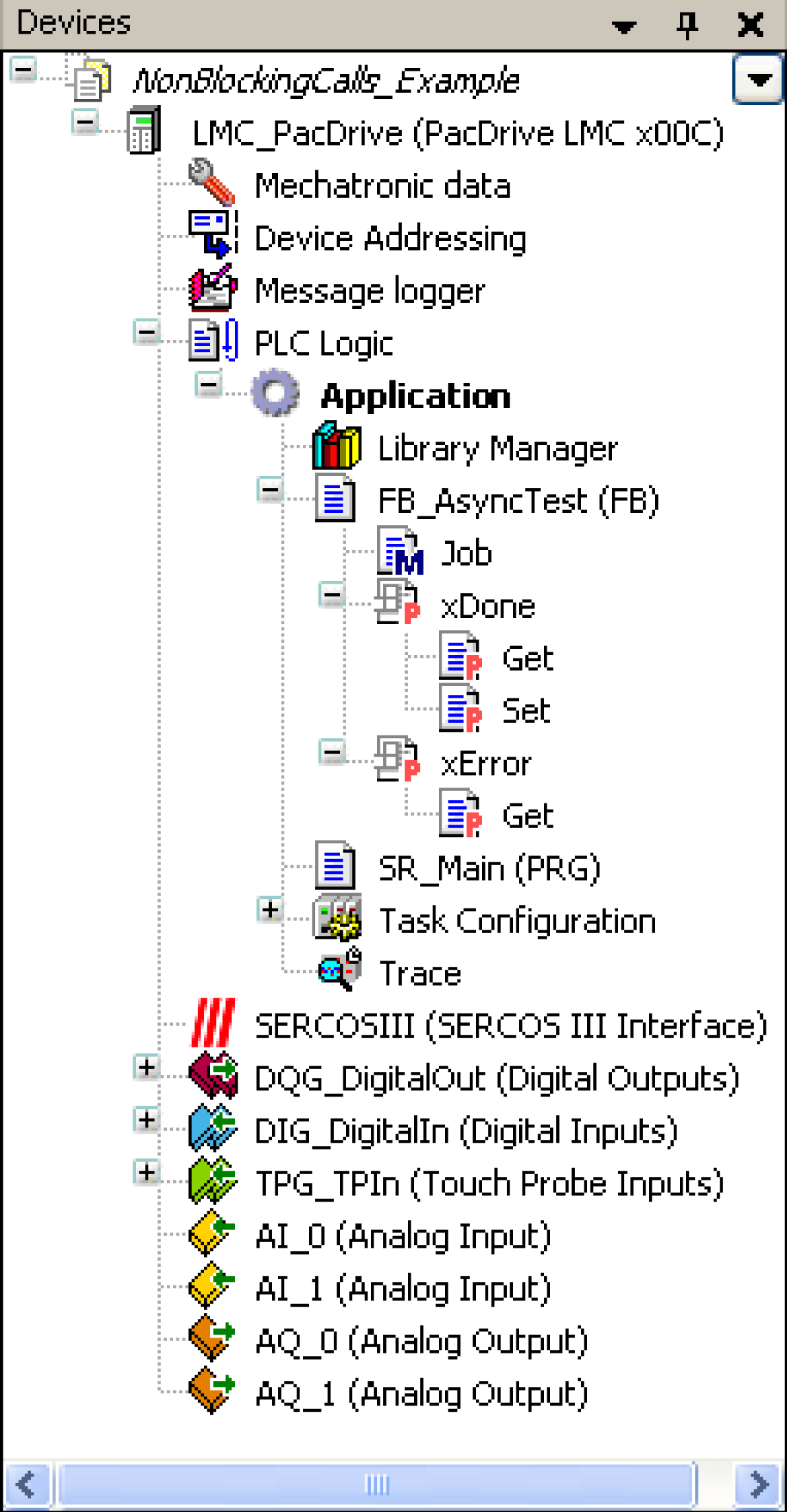This chapter contains a program example with an example code that is used for executing an asynchronous method.
Program example FB_AsyncTest

If you want to use the asynchronous mechanism to asynchronously execute a code section or to create own function blocks and to asynchronously call-up a method in an additional task, you have to implement a function block that implements the IF_Async interface.
You can implement this by either using the function blocks you have programmed, as described in this program example, or by using the function blocks of the PD_PacDriveLib library listed here.
The code that is to be executed asynchronously has to be written into the Job() method. An instance of the function block implementing IF_Async has to be transferred to G_ifAsyncMgr.Start(i_ifAsync:=).
In the present example, FB_AsyncTest implements the IF_Async interface. The FB_AsyncTest is a specially created sample function block providing the code to be asynchronously executed.
For fbAsnycTest: FB_AsyncTest a correct call-up would be as follows:
G_ifAsyncMgr. Start (i_ifAsyncInst := fbAsyncTest);
A StateMachine has to be created and it must be waited in this state until the xDone property of the FB_AsyncTest function block equals TRUE.
The Job() method contains the code to be asynchronously executed, e.g. read or write values on the SERCOS service channel. The xDone property is set depending on which code section in the Job() method is executed or not.
Declaration
FUNCTION_BLOCK FB_AsyncTest IMPLEMENTS PDL.IF_Async
VAR
etDiag : GD.ET_Diag;
etDiagExt : PDL.ET_DiagExt;
xBusy : BOOL;
xInitDone : BOOL;
xDone_loc : BOOL;
xError_loc : BOOL;
END_VAR
Program
// This FB initializes the extra task and takes care, that your time consuming function gets called from this task
IF PDL.G_ifAsyncMgr <> 0 THEN
PDL.G_ifAsyncMgr.Init(q_xBusy=> xBusy, q_xDone=> xInitDone ,
q_etDiag=> etDiag , q_etDiagExt=> etDiagExt );
IF etDiag <> GD.ET_Diag.Ok THEN
xError_loc:= TRUE; // Error Reaction see Online Help for possible diag codes
ELSIF xInitDone THEN
PDL.G_ifAsyncMgr.Start(i_ifAsync:= THIS^, q_etDiag=> etDiag ,
q_etDiagExt=> etDiagExt);
IF etDiag <> GD.ET_Diag.Ok THEN
xError_loc:= TRUE; // Error Reaction see Online Help for possible diag codes
END_IF
END_IF
END_IF
FB_AsyncTest - Job method and its properties
Declaration
METHOD Job : BOOL
Program
// Function which needs time and would block the main task
// This function is now executed in a extra low priority task (31)
PDL.FC_WaitTime(i_rWTime:= 1000); // here is your code
PDL.FC_WaitTime(i_rWTime:= 500); // here is your code
PDL.FC_WaitTime(i_rWTime:= 250); // here is your code
Properties FB_AsyncTest.xDone, FB_AsyncTest.xDone.Get and FB_AsyncTest.xDone.Set
FB_AsyncTest.xDone
PROPERTY xDone : BOOL
FB_AsyncTest.xDone.Get
xDone:= xDone_loc;
FB_AsyncTest.xDone.Set
xDone_loc:= xDone;
Properties FB_AsyncTest.xError and FB_AsyncTest.xError.Get
FB_AsyncTest.xError
PROPERTY PUBLIC xError : BOOL
FB_AsyncTest.xError.Get
xError:= xError_loc;
Declaration
PROGRAM SR_Main
VAR
fbAsyncTest: FB_AsyncTest;
diState: DINT;
xStart: BOOL;
END_VAR
Program
CASE diState OF
10: // Application wait for start
IF xStart THEN
diState:= 20;
END_IF
20: // operation
;
100: // Error State
;
ELSE
fbAsyncTest(); // This FB initializes the extra task and takes care, that your time consuming function gets called from this task
IF fbAsyncTest.xDone THEN // Signals that it is done
diState:= 10; // now you can continue your application as usual
ELSIF fbAsyncTest.xError THEN // Signals an error
diState:= 100; // Sets application in Error State
END_IF
END_CASE